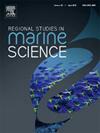Spatio-temporal variability of coastal currents along the Yucatan Peninsula using Self‐Organising Maps
IF 2.1
4区 环境科学与生态学
Q3 ECOLOGY
引用次数: 0
Abstract
The characterisation of oceanic and coastal variability around the Yucatan Peninsula is important for understanding the physical processes involved, which have an environmental, social and economic impacts at a both local and regional scales. In particular, understanding the coastal dynamics in the region facilitates the conservation of ecosystemic services, the identification and prevention of vulnerable situations, the identification of risks and management practices, as well as the evaluation of the effects of environmental and anthropogenic changes. In the present study, oceanic and atmospheric numerical models are used, with a high spatial and temporal resolution. These models have been validated with in situ data and simulations range from the continental platform (regional) to the coastal zone (local). The forcings involved under different climatic events (e.g. average conditions, storms and northerlies) and their influence on coastal dynamics at different spatial and temporal scales are studied. The model performed particularly well when comparing wave heights, wave period and wave direction with field data for the different events. In terms of current variability, the trends identified in the results are supported by previous findings of specific field case studies. Spatial and temporal patterns of the currents' velocities identified through Self-Organising Maps, with time dependence given by their best matching units, can reproduce the characteristic patterns of surface current variability. The results of the present study show that the northern coast of the Yucatan Peninsula can be divided into three main regions: 1) the east, mostly controlled by the Yucatan Current; 2) the central region, which is more of a transition zone; and 3) the west, off the coast of Campeche, influenced primarily by atmospheric processes (e.g. sea-land breezes and northerlies). The main surface currents along the northern Yucatan Peninsula Coast are generally to the west but show effects of sea-land breezes and northerlies.
求助全文
约1分钟内获得全文
求助全文
来源期刊

Regional Studies in Marine Science
Agricultural and Biological Sciences-Ecology, Evolution, Behavior and Systematics
CiteScore
3.90
自引率
4.80%
发文量
336
审稿时长
69 days
期刊介绍:
REGIONAL STUDIES IN MARINE SCIENCE will publish scientifically sound papers on regional aspects of maritime and marine resources in estuaries, coastal zones, continental shelf, the seas and oceans.
 求助内容:
求助内容: 应助结果提醒方式:
应助结果提醒方式:


